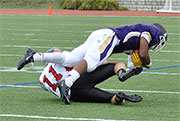
THURSDAY, Sept. 18, 2014 (HealthDay News) — Researchers are trying to learn more about a condition called sickle cell trait, which can cause sudden death in young athletes.
In people with sickle cell trait, intense physical activity, heat and dehydration can cause muscle breakdown that can lead to kidney damage and cardiac arrest. Between 2000 and 2014, nine collegiate football players in the United States collapsed and died during training and were later found to have sickle cell trait.
“More student-athletes with sickle cell trait have died than those with any other condition, including heart defects,” Dr. John Wood, of the Saban Research Institute at Children’s Hospital Los Angeles, said in a hospital news release.
“Sickle cell trait should not be a barrier to an active lifestyle or competitive sports, but the problem is that many people won’t have any warning symptoms. Because of that, they don’t even know they have this condition and can’t take the necessary precautions,” he added.
Sickle cell trait occurs in people who have one abnormal hemoglobin gene and one normal gene. They do not usually have any symptoms of sickle cell disease, but they can pass the trait on to their children, according to the U.S. Centers for Disease Control and Prevention. About one in 12 black people and about 2 million people overall in the United States are affected, and most of them don’t know they have the condition.
Recently, sickle cell trait testing became mandatory for all U.S. Armed Forces recruits and all NCAA Division I and II athletes.
“How sickled hemoglobin in the red blood cell triggers such rapid muscle damage (in people with sickle cell trait) is quite a puzzle,” Wood said. “It is also unclear why only a few athletes are stricken when so many others participate under harsh conditions without difficulty. That’s what we are trying to find out.”
The researchers so far have “found that individuals with SCT exercised to lower oxygen levels and red cell energy reserves than people with regular hemoglobin. This could allow SCT athletes to unknowingly push their muscles to dangerously low oxygen and energy levels during rigorous activity,” Wood said.
He and his team are now studying how the body regulates blood flow to the muscles and brain in people with sickle cell trait and in those with sickle cell disease. Those findings could help identify who is at serious risk during intense exercise.
More information
The U.S. Centers for Disease Control and Prevention has more about sickle cell trait.
Copyright © 2025 HealthDay. All rights reserved.

